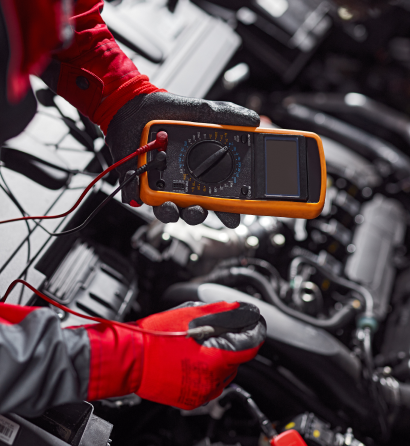Cooling System Service
- Identify Signs of Cooling System Issues: Some common signs indicating cooling system problems include:
- Engine overheating or temperature gauge rising into the red zone
- Coolant leaks underneath the vehicle or around the radiator, hoses, or water pump
- Low coolant level in the overflow reservoir
- Engine running hotter than usual or fluctuating temperature gauge readings
- Check Coolant Level and Condition: Allow the engine to cool before checking the coolant level in the overflow reservoir. Ensure the coolant level is between the minimum and maximum marks on the reservoir. Additionally, inspect the coolant for signs of contamination, such as oil or debris, which may indicate underlying issues.
- Inspect Hoses and Connections: Visually inspect radiator hoses, heater hoses, and hose connections for signs of wear, leaks, or damage. Replace any worn or damaged hoses to prevent coolant leaks and ensure proper coolant circulation.
- Test Coolant Strength and pH: Use a coolant hydrometer or test strips to measure the concentration of coolant and check its pH level. The coolant should have the appropriate concentration of antifreeze to water (usually 50/50) and a proper pH level to prevent corrosion and freezing.
- Flush and Replace Coolant: Over time, coolant can become contaminated with rust, scale, and debris, leading to reduced cooling efficiency and potential engine damage. Perform a cooling system flush to remove old coolant and contaminants, then refill the system with fresh coolant according to the manufacturer’s specifications.
- Inspect Radiator and Cap: Check the radiator for signs of corrosion, damage, or blockages, such as bent fins or debris buildup. Inspect the radiator cap for cracks, deterioration, or a faulty pressure relief valve, which can cause coolant leaks or system pressure issues.
- Test Radiator Fan Operation: Ensure that the radiator fan(s) operate properly when the engine reaches operating temperature. Faulty radiator fans can lead to inadequate cooling, especially at low speeds or in stop-and-go traffic.
- Check Water Pump: Inspect the water pump for leaks, corrosion, or unusual noises, which may indicate a failing water pump. The water pump is responsible for circulating coolant through the engine and radiator, so any issues should be addressed promptly to prevent overheating.
- Inspect Thermostat: Check the thermostat for proper operation by testing it in hot water to ensure it opens and closes at the correct temperature. A stuck thermostat can cause overheating or insufficient engine warming, leading to poor fuel economy and emissions.
- Bleed Air from Cooling System: After refilling the cooling system with coolant, bleed any trapped air from the system by following the manufacturer’s recommended bleeding procedure. Trapped air can impede coolant flow and cause overheating.
- Perform Pressure Test: Consider performing a pressure test on the cooling system to check for leaks and ensure system integrity. A pressure tester applies pressure to the cooling system to simulate operating conditions and identify any leaks or weaknesses.
- Document Service and Maintenance: Keep records of cooling system service and maintenance, including coolant type, replacement intervals, and any repairs performed. This documentation helps track maintenance history and ensures timely servicing in the future.



